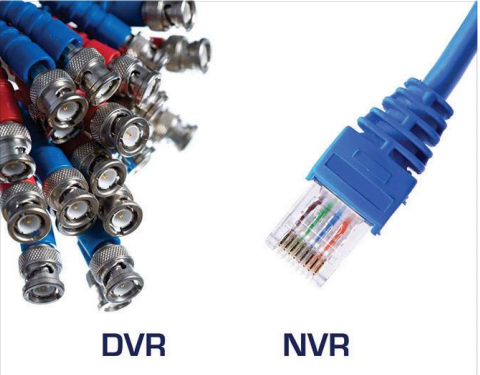What is the Difference Between NVR and DVR PDF?
In today’s world, where security is paramount, choosing the right surveillance system can make a significant difference in safeguarding your property. Two of the most common types of video recording systems are Network Video Recorders (NVR) and Digital Video Recorders (DVR). Understanding the differences between these systems is crucial for making an informed decision. This blog post will delve into the key differences between NVR and DVR, providing a comprehensive guide to help you choose the right system for your needs. Additionally, we offer a detailed PDF guide for those who prefer a downloadable reference.
Understanding NVR and DVR
What is an NVR?
A Network Video Recorder (NVR) is a specialized computer system that records video footage in a digital format to a disk drive, USB flash drive, SD memory card, or other mass storage devices. Unlike DVRs, NVRs are designed to work with IP cameras, which capture and send video data over a network. This setup allows for higher-resolution video and more flexible camera placement.
How NVR Works:
- IP Cameras: NVR systems use IP cameras that capture video and transmit it over an Ethernet network. These cameras are connected to the NVR via a network switch or router.
- Data Processing: The cameras process and encode the video data, which they then send to the NVR for storage and further processing.
- Remote Access: NVRs typically support remote access, allowing users to view live or recorded footage from anywhere via the Internet.
Types of NVR Systems:
- PoE NVR (Power over Ethernet): These systems use a single Ethernet cable to provide both power and data to the cameras, simplifying installation.
- Wireless NVR: These systems connect to cameras wirelessly, offering even more flexibility in camera placement, but may be subject to network interference.
What is a DVR?
A Digital Video Recorder (DVR) is a system that records video in a digital format, primarily using analogue cameras. DVRs are commonly used in traditional CCTV systems and are known for their straightforward setup and lower cost than NVRs.
How DVR Works:
- Analog Cameras: DVR systems use analogue cameras that capture video and send it to the DVR via coaxial cables.
- Data Processing: The DVR processes and encodes the video data, which converts the analogue signals into digital format for storage.
- Local Access: DVRs are generally accessed locally, with remote access capabilities being more limited than NVRs.
Types of DVR Systems:
- Analog DVR: Traditional DVR systems that work exclusively with analogue cameras.
- Hybrid DVR: These systems can work with analogue and IP cameras, offering a bridge for those transitioning from older systems to newer IP-based setups.
Key Differences Between NVR and DVR

Technology and Functionality
NVR Technology:
- IP Cameras: NVR systems use IP cameras that capture and process video data before sending it over a network.
- Network-Based: The video data is transmitted over an Ethernet network, allowing for high-resolution video and flexible camera placement.
DVR Technology:
- Analog Cameras: DVR systems use analogue cameras that send raw video data to the DVR for processing.
- Coaxial Cables: The video is transmitted via coaxial cables, which can limit the resolution and flexibility of camera placement.
Installation and Setup
NVR Installation:
- Ethernet Cables: NVR systems require Ethernet cables for connecting cameras to the network.
- Simplified Setup: With PoE NVR systems, a single cable provides power and data, simplifying the installation process.
DVR Installation:
- Coaxial Cables: DVR systems use coaxial cables to connect cameras to the DVR.
- More Cables: Each camera requires a separate power cable, making the installation more complex.
Video Quality and Resolution
NVR Video Quality:
- Higher Resolution: NVR systems can support higher resolution cameras, often up to 4K or higher, providing clearer and more detailed video footage.
DVR Video Quality:
- Lower Resolution: DVR systems are generally limited to lower resolution cameras, typically up to 1080p, which may not be sufficient for detailed surveillance needs.
Scalability and Flexibility
NVR Scalability:
- Flexible Expansion: NVR systems can easily integrate additional IP cameras, making them highly scalable for growing surveillance needs.
DVR Scalability:
- Limited Expansion: DVR systems are more limited in scalability, as adding more cameras often requires additional hardware and more complex wiring.
Cost Comparison
NVR Costs:
- Higher Initial Cost: NVR systems generally have a higher initial cost due to the need for IP cameras and network infrastructure.
- Long-Term Savings: NVR systems may offer long-term savings due to easier maintenance and scalability despite the higher upfront cost.
DVR Costs:
- Lower Initial Cost: DVR systems are typically less expensive to set up initially, as analogue cameras and coaxial cables are cheaper.
- Potential Hidden Costs: Over time, the cost of adding more cameras and maintaining the system can increase.
Security Features
NVR Security:
- Advanced Features: NVR systems often have advanced security features, such as encryption, motion detection, and remote access controls.
- Network Security: Since NVRs are network-based, they require robust security measures to prevent unauthorized access.
DVR Security:
- Basic Features: DVR systems typically offer security features like motion detection and local access controls.
- Physical Security: DVR systems rely more on physical security measures due to their local nature.
Pros and Cons of NVR and DVR
Pros of NVR
High Video Quality:
- Superior Resolution: NVR systems support higher resolution cameras, often up to 4K or higher, providing clearer, more detailed video footage. This is particularly advantageous for identifying details such as facial features or license plates.
- Digital Processing: Since IP cameras process and encode video data before sending it to the NVR, the overall video quality is maintained without degradation.
Easier Remote Access:
- Internet Connectivity: NVR systems are designed to be accessed over the Internet. You can view live or recorded footage from anywhere worldwide using a smartphone, tablet, or computer.
- User-Friendly Apps: Most NVR systems have companion apps that make remote access and management straightforward and convenient.
Better Scalability:
- Flexible Expansion: Adding additional cameras to an NVR system is typically straightforward. New IP cameras can easily be integrated into the network without significant rewiring or additional hardware.
- Future-Proofing: NVR systems are more adaptable to future technological advancements, making them a better long-term investment.
Cons of NVR
Higher Initial Cost:
- Expensive Equipment: The initial setup cost for an NVR system is generally higher due to the need for IP cameras and network infrastructure.
- Advanced Features: While these features are beneficial, they come at a price, making NVR systems more expensive upfront than DVR systems.
More Complex Setup:
- Network Configuration: Setting up an NVR system can be more complex, requiring a good understanding of network configuration and IP addressing.
- Technical Expertise: While PoE (Power over Ethernet) simplifies the process, some technical expertise is still required to ensure optimal performance and security.
Pros of DVR
Lower Initial Cost:
- Affordable Equipment: DVR systems are generally less expensive to set up initially. Analogue and coaxial cables are cheaper than IP cameras and Ethernet cables.
- Cost-Effective for Small Systems: DVR systems can be a more cost-effective solution for smaller setups.
Simpler Setup for Smaller Systems:
- Basic Wiring: DVR systems use coaxial cables, which are straightforward to install. Each camera connects directly to the DVR, simplifying the setup process.
- Less Technical Knowledge Required: The installation and configuration of DVR systems are generally simpler, making them more accessible for those with limited technical knowledge.
Cons of DVR
Lower Video Quality:
- Resolution Limitations: DVR systems are typically limited to lower-resolution cameras, usually up to 1080p. This may not be sufficient for applications requiring detailed surveillance.
- Analog Signal Degradation: The analogue video signals can degrade over long distances, affecting the overall video quality.
Limited Scalability:
- Hardware Constraints: Adding more cameras to a DVR system often requires additional hardware, such as more DVR units or complex wiring setups.
- Expansion Challenges: Expanding a DVR system can be more cumbersome and costly, particularly for larger installations.
Choosing the Right System for Your Needs
Assessing Your Security Requirements
Assessing your security needs is essential when deciding between an NVR and a DVR system. Consider factors such as the area size you need to monitor, the number of cameras required, and your budget. Here are some key points to consider:
- Location Size: Larger areas may benefit more from the higher resolution and scalability of NVR systems.
- Number of Cameras: The scalability of NVR systems can be advantageous if you need many cameras.
- Budget: NVR systems have higher upfront costs but may offer better value in the long run due to their advanced features and scalability.
Future-Proofing Your Security System
Importance of Future Expansion:
- Technological Advancements: Security technology is continually evolving. Choosing a system that can adapt to future advancements ensures that your investment remains valuable.
- Scalability: NVR systems are generally more adaptable to future needs, making them a better choice for expanding a security system.
How NVR and DVR Systems Can Adapt:
- NVR: Easily integrates new IP cameras and supports higher resolutions, making it a future-proof option.
- DVR: While more limited, hybrid DVR systems can offer flexibility by supporting analogue and IP cameras.
Professional Installation vs. DIY
Benefits of Professional Installation:
- Expertise: Professional installers have the expertise to ensure your system is set up correctly and optimally.
- Time-Saving: Hiring professionals can save you time and reduce installation hassle.
- Warranty and Support: Many professional installers offer warranties and ongoing support, providing peace of mind.
Tips for DIY Installation:
- Research: Thoroughly research the installation process for your chosen system. Many manufacturers provide detailed guides and tutorials.
- Tools and Equipment: Ensure you have all the necessary equipment before installing.
- Network Configuration: For NVR systems, familiarize yourself with basic network configuration to ensure proper setup and security.
Frequently Asked Questions (FAQs)
Can NVR and DVR Systems Be Used Together?
Hybrid Systems:
- Explanation: Hybrid systems combine the features of both NVR and DVR, allowing the use of analogue and IP cameras within the same system.
- Benefits: This setup can benefit those transitioning from an older DVR system to a newer NVR system, providing flexibility and cost savings.
What Are the Storage Options for NVR and DVR?
Internal and External Storage Solutions:
- Internal Storage: NVR and DVR systems typically store video footage with internal hard drives. The storage capacity can vary, ranging from a few terabytes to several dozen terabytes.
- External Storage: NVR and DVR systems can be expanded with external storage solutions such as network-attached (NAS) devices or external hard drives for additional storage. This allows for greater storage capacity and redundancy.
How Secure Are NVR and DVR Systems?
Security Features:
- NVR Systems typically offer advanced security features such as encryption, user authentication, and secure remote access. However, because they are network-based, they require robust network security measures (e.g., firewalls and VPNs) to prevent unauthorized access.
- DVR Systems: Generally rely more on physical security measures. They offer basic security features like motion detection and local access controls but may lack the advanced security features of NVR systems.
Can I Upgrade My Existing DVR System to an NVR System?
Transitioning to NVR:
- Hybrid DVR: If you have a hybrid DVR system, you can gradually add IP cameras while using your existing analogue cameras.
- Complete Upgrade: For a full transition, you must replace your analogue cameras with IP cameras and ensure your network infrastructure can support the new system.
What Are the Maintenance Requirements for NVR and DVR Systems?
Regular Maintenance Tasks:
- Firmware Updates: Regularly update the firmware of both NVR and DVR systems to ensure they are running the latest security patches and features.
- Storage Management: Monitor storage capacity and manage video retention policies to prevent overload.
- Camera Maintenance: Regularly clean and inspect cameras to ensure they function correctly and capture clear footage.
Choosing between an NVR and a DVR system depends on your specific security needs, budget, and future expansion plans. NVR systems offer higher video quality, better scalability, and more advanced features, making them ideal for larger or more complex installations. On the other hand, DVR systems are more cost-effective for smaller setups and simpler to install and maintain.
By understanding the key differences, pros and cons, and specific use cases for each system, you can make an informed decision that best suits your security requirements. Whether you opt for an NVR or DVR system, both types offer robust solutions to enhance the security of your property.
Download our PDF guide on NVR and DVR systems.
Download the Comprehensive Guide
For those who prefer a detailed, downloadable reference, we have created a comprehensive PDF guide that delves deeper into the differences between NVR and DVR systems. This guide includes additional charts, tables, and case studies to help you make the best decision for your security needs.
Download the Comprehensive NVR vs. DVR Guide (PDF)
Further Reading
- “The Future of Surveillance: Trends in NVR and DVR Technology“ – Explore upcoming trends and advancements in surveillance technology.
- “How to Secure Your NVR/DVR System from Cyber Threats” – Learn best practices for securing your surveillance system against cyber threats.
- “Case Studies: Successful Implementations of NVR and DVR Systems” – Read about real-world applications and success stories of NVR and DVR systems in various industries.
Case Studies: Real-World Applications of NVR and DVR Systems
Case Study 1: Retail Store Chain
Overview:
A national retail store chain wanted to upgrade its security system to improve loss prevention and enhance customer safety. The analogue DVR system was outdated and lacked the resolution and remote monitoring capabilities needed for effective surveillance.
Solution:
- NVR System Implementation: The chain implemented an NVR system across all locations.
- High-Resolution IP Cameras: Installed 4K IP cameras to cover critical areas such as entrances, exits, and cash registers.
- Centralized Monitoring: Set up a centralized monitoring centre that allowed security personnel to view live and recorded footage from all store locations.
- Remote Access: Enabled store managers to access the surveillance system remotely via secure mobile apps.
Results:
- Improved Loss Prevention: The higher resolution cameras helped identify shoplifters and fraudulent activities more effectively.
- Enhanced Safety: The ability to monitor multiple locations in real-time improved the overall safety of customers and staff.
- Operational Efficiency: Centralized monitoring reduced the need for on-site security personnel and improved incident response times.
Case Study 2: Small Business Office
Overview:
A small business office with a limited budget needed a cost-effective surveillance solution to monitor its premises, including the main entrance, parking lot, and office interior.
Solution:
- DVR System Implementation: Due to its lower initial cost, we installed a DVR system.
- Analog Cameras: Deployed 1080p analogue cameras to cover key areas.
- Local Storage: Used a DVR unit with sufficient internal storage to retain video footage for up to 30 days.
- Basic Remote Access: Enabled remote access via a simple mobile app for the business owner.
Results:
- Cost Savings: The DVR system provided a budget-friendly solution that met the business’s security needs.
- Adequate Coverage: The analogue cameras delivered sufficient video quality for monitoring and reviewing incidents.
- Peace of Mind: The business owner could check in on the office remotely, providing peace of mind and improving security management.
Case Study 3: University Campus
Overview:
A large university campus requires a comprehensive surveillance system to ensure the safety of students, staff, and property. The system needed to cover multiple buildings, outdoor areas, and parking lots.
Solution:
- Hybrid System Implementation: Opted for a hybrid system to leverage existing analogue cameras while gradually integrating new IP cameras.
- Mixed Camera Setup: Deployed a combination of high-resolution IP cameras in critical areas and retained existing analogue cameras in less critical zones.
- Network Infrastructure: Upgraded the campus network to support the new IP cameras and ensure reliable connectivity.
- Advanced Analytics: Implemented video analytics features such as motion detection, facial recognition, and license plate recognition.
Results:
- Comprehensive Coverage: The hybrid system provided extensive coverage across the campus, enhancing overall security.
- Cost-Effective Transition: Gradually integrating IP cameras allowed the university to manage costs while upgrading its surveillance capabilities.
- Enhanced Security Features: Advanced analytics improved the ability to detect and respond to potential security threats.
Case Study 4: Industrial Facility
Overview:
An industrial facility with critical infrastructure needs a robust surveillance system to monitor its operations, ensure worker safety, and protect valuable assets.
Solution:
- NVR System Implementation: Installed an NVR system to use high-resolution video and advanced features.
- Specialized IP Cameras: Deployed specialized IP cameras with thermal imaging and night vision to monitor hazardous areas and low-light environments.
- Scalable Storage: Used NAS devices for scalable storage solutions to handle the large volume of video data.
- Integration with Access Control: The NVR system was integrated with the facility’s access control system to enhance security and monitoring capabilities.
Results:
- Enhanced Monitoring: The high-resolution and specialized cameras provided clear and detailed footage, even in challenging environments.
- Improved Safety: The ability to monitor hazardous areas in real time contributed to increased worker safety.
- Efficient Incident Response: Integration with access control systems allowed quicker and more effective responses to security incidents.
Key Takeaways from Case Studies
- NVR Systems are ideal for large-scale installations that require high-resolution video, centralized monitoring, and advanced features. They are suitable for environments such as retail chains, universities, and industrial facilities where scalability and future-proofing are important.
- DVR Systems: Cost-effective for smaller setups with limited budgets, such as small business offices. They provide adequate security coverage with simpler installation and maintenance requirements.
- Hybrid Systems: Offer a flexible solution for organizations transitioning from analogue to IP cameras, allowing for a gradual upgrade while managing costs.
Conclusion
Real-world applications of NVR and DVR systems highlight their strengths and suitability for different environments. By understanding your security setup’s specific needs and constraints, you can choose the system that best meets your requirements: an NVR for high-resolution and advanced features, a DVR for cost-effective simplicity, or a hybrid system for flexible integration.
For more detailed insights and practical advice, refer to our comprehensive PDF guide and explore additional case studies and resources.
Download the Comprehensive NVR vs. DVR Guide (PDF)










